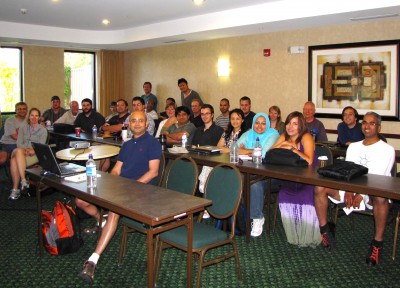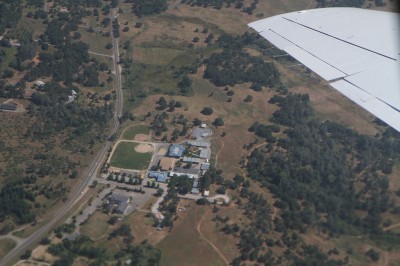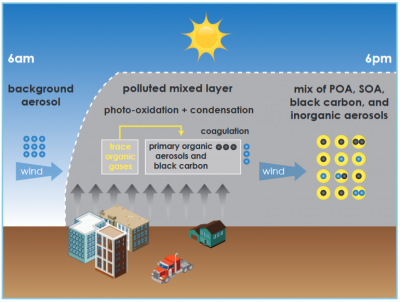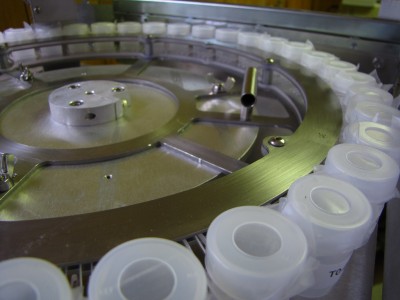
During 26 days of research flights and ground-based measurements for the Carbonaceous Aerosols and Radiative Effects Study (CARES), these busy experts put together a CARES package: a rich and public data set on the composition, evolution, and fate of aerosols in an air transport region where natural and urban emissions mix. The outdoor laboratory for CARES was Sacramento, California, and its environs. The city shares an air transport pathway with a largely uninhabited forest about 40 km downwind.
Summertime wind patterns in the area have a predictable “flow regularity,” said CARES principal investigator Rahul Zaveri, an ASR scientist at the Pacific Northwest National Laboratory (PNNL). “It was quite attractive for the kind of sampling we wanted to do.”
Broadly speaking, Sacramento represents the global future: more and bigger cities intersecting with natural areas, and swapping air emissions with still-unknown consequences.
“With urbanization happening the way it is, we’re encroaching upon natural regimes all the time,” said Jerome Fast, also a PNNL ASR scientist. He was lead author of a 2014 CARES paper on regional modeling variability, and before then contributed significantly to the chemistry version of the widely used Weather Research and Forecasting model.
Keeps on Giving
Since 2011, the study has inspired more than 30 papers, sparked 600-plus citations, and spurred a second generation of lab-based studies: mostly environmental chamber investigations trying to puzzle out some of the surprises to emerge from CARES.
For instance, one paper by Laskin et al., observed that sea salt particles swept into Sacramento air from the Pacific coast 100 km away survived in a form puzzlingly stripped of chloride.
“Overall, it’s a very comprehensive data set that people are still using,” said Zaveri. He was lead author on the CARES overview paper and co-authored nine others.

On the ground were two “heavily instrumented” sites, said Zaveri: one within the urban plume and a second about 40 km northeast in the forested Sierra Nevada foothills in the eponymously named Cool, California.
Adding to the science effort during CARES were the California Air Resources Board, the National Oceanic and Atmospheric Administration, and the California Energy Commission, which had a similar aerosols assessment campaign underway in the summer of 2010.
Opening the Package
Aerosols that contain carbon, the chief research target of CARES, undergo chemical and physical transformations as they disperse microscopically through the air. They heavily influence cloud formation, the lifespan of clouds, and the Earth’s radiation balance: how much sunlight the planet either absorbs or reflects. Despite their centrality to understanding the atmosphere, aerosols are the largest source of uncertainty in global and regional climate models.
Aerosols are created by natural and man-made sources, both of which were accounted for in the study. Sacramento is upwind of a largely unpopulated area of pine and oak trees known as Blodgett Forest in the Sierra Nevada mountain range.
The same template of research terrain was also a good place to see how urban emissions evolved as they progressed from city to forest. “Pollutants undergo many changes after they are emitted,” said Zaveri, touching on the chemical and morphological mutability that makes climate prediction so challenging. “These particles grow and their properties change.”

SOAs come from both man-made and natural sources. Even without cities, he said, there would be SOAs, a by-product of isoprene and terpenes being pumped into the atmosphere by forest settings the world over. But CARES research underlined a finding already established about other locations: that biogenic SOAs from trees, when mixed with anthropogenic varieties, perturb the atmospheric chemistry and enhance biogenic production of SOA. “It’s like you put lighter fluid on your charcoal grill,” said Fast. “You speed things up.”
String of Aerosol Papers
So far, some of the papers to emerge from CARES note that black carbon aerosols and their optical (light-scattering) properties are not well represented in current climate models. Atmospheric black carbon, an irregularly shaped fractal product emitted from man-made sources like tailpipe emissions, warms the Earth’s climate and is a prominent target for climate change mitigation measures. Once emitted, it mixes with other aerosol components, which fill in its fractal irregularities to form sphere-like bodies that act like lenses and speed up heat absorption. Those “absorption enhancements” are thought to double the effect black carbon has on warming.
But one paper in Science (Cappa et al.) used direct in situ measurements from CARES to show that those enhancements to black carbon are more in the range of 6 percent, not 100 percent. Like many other CARES discoveries, the black carbon surprise has inspired lab-based studies of the aerosol’s optical properties.
Other papers inspired by CARES note that previous models tended to under-predict SOA formation in both the urban atmosphere and in the upper troposphere. It appears that mixing urban and natural emissions enhances SOA formation, “for reasons we don’t fully understand,” said Zaveri, echoing Fast. “But now we have more evidence of this phenomenon.”

Another SOA paper (Vaden et al.) found that SOA evaporated much more slowly than models typically indicate, taking 10 to 20 hours to do so. “That basically means we were modeling SOA incorrectly,” said Zaveri, who authored a 2014 paper proposing a new framework for modeling SOA.
The Vaden paper inspired lab studies, including one at PNNL, on viscosity: a liquid-like SOA would evaporate faster than an SOA that was “highly viscous and sticky,” said Zaveri.
Vaden’s findings are still controversial among SOA researchers even six years after the last CARES instrument was packed up for another ARM campaign. “There are multiple pathways depending on where you are,” said Fast of the SOA findings, underpinning his belief is that there is a “regionality” to CARES climate data, just as there is to data gathered in Amazonia. “Everybody’s trying to get to the next step.”
Controversial or not, the Vaden study was the first in the long list inspired by CARES and started things off with a bang: It was a Web of Science “highly cited” paper.
# # #
For more information about this study, read the PNNL highlight, “Why we care about carbonaceous aerosols,” and see the full list of papers.
ASR CARES Package of Science
Published: 27 June 2016

